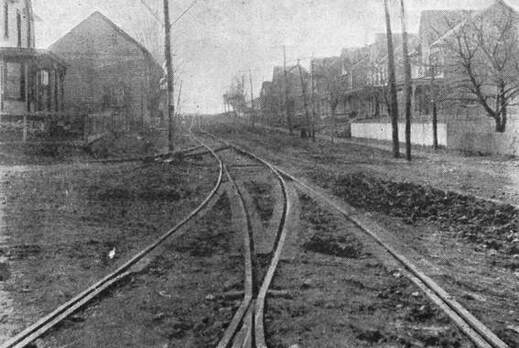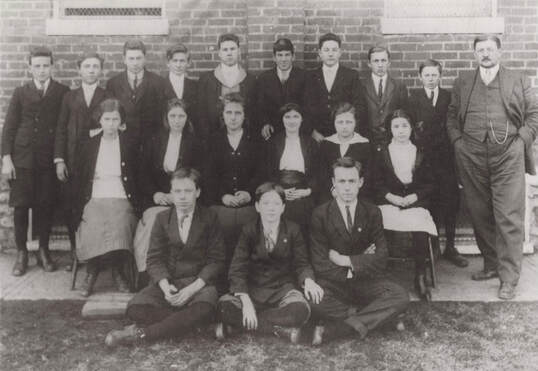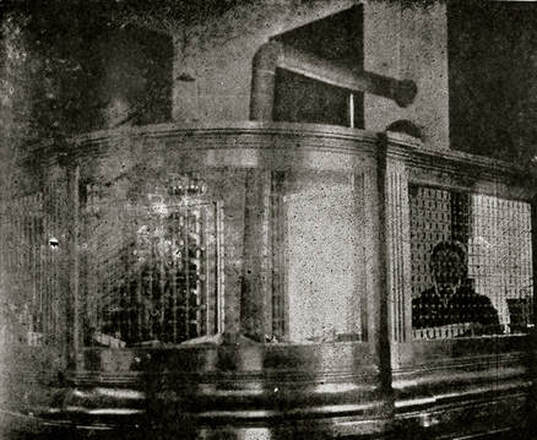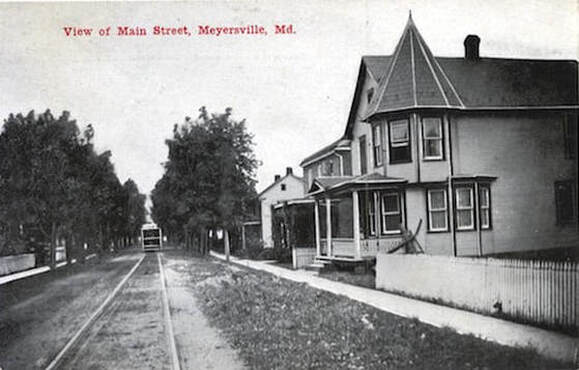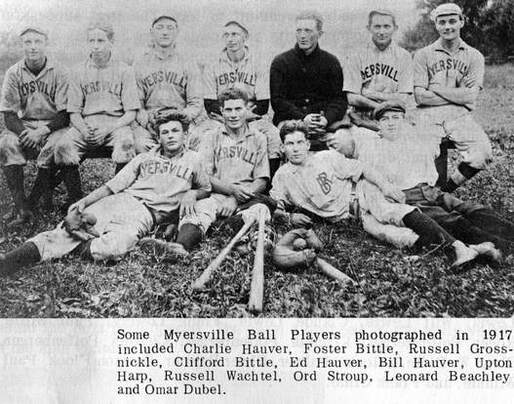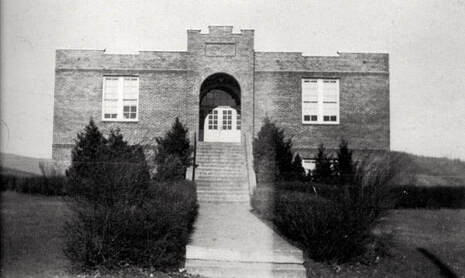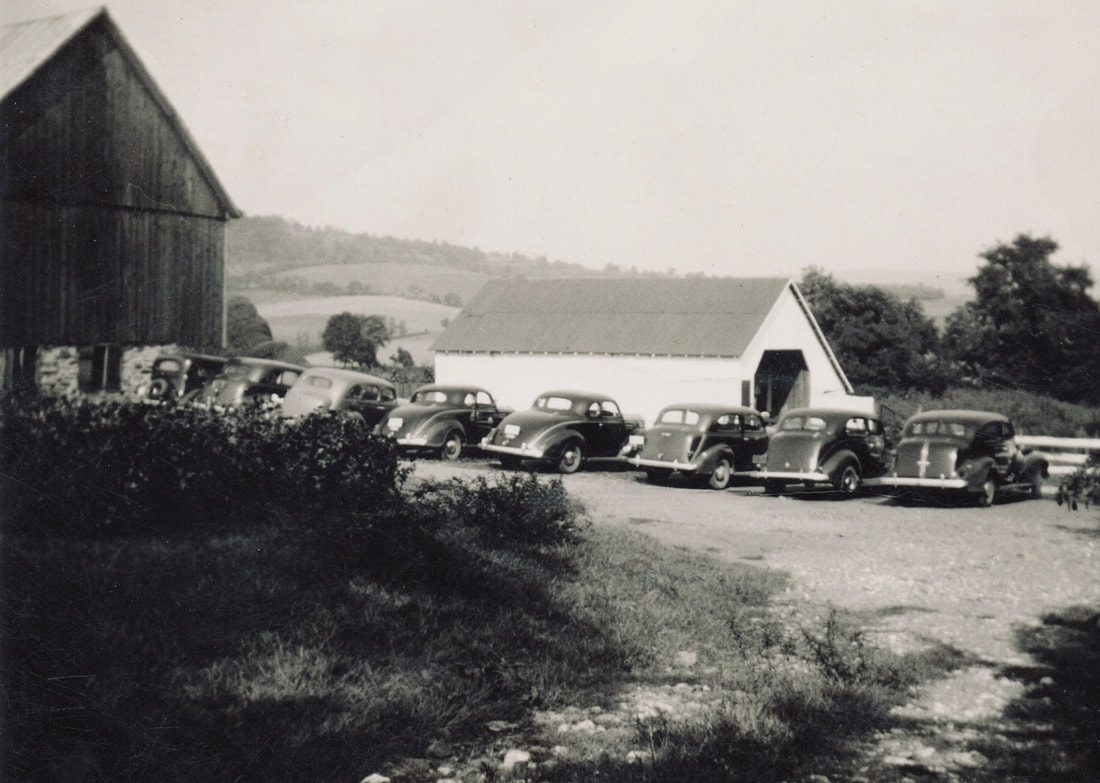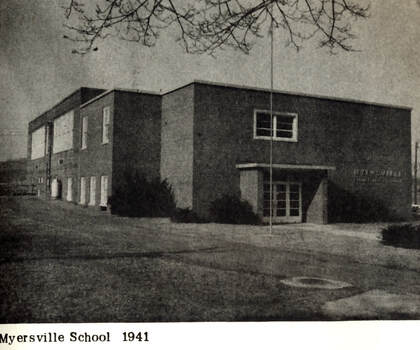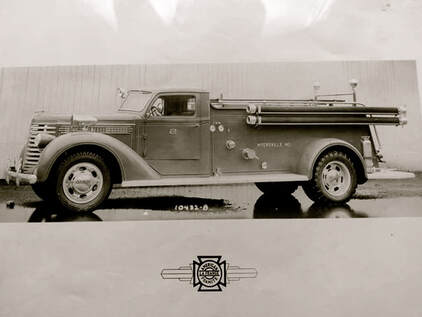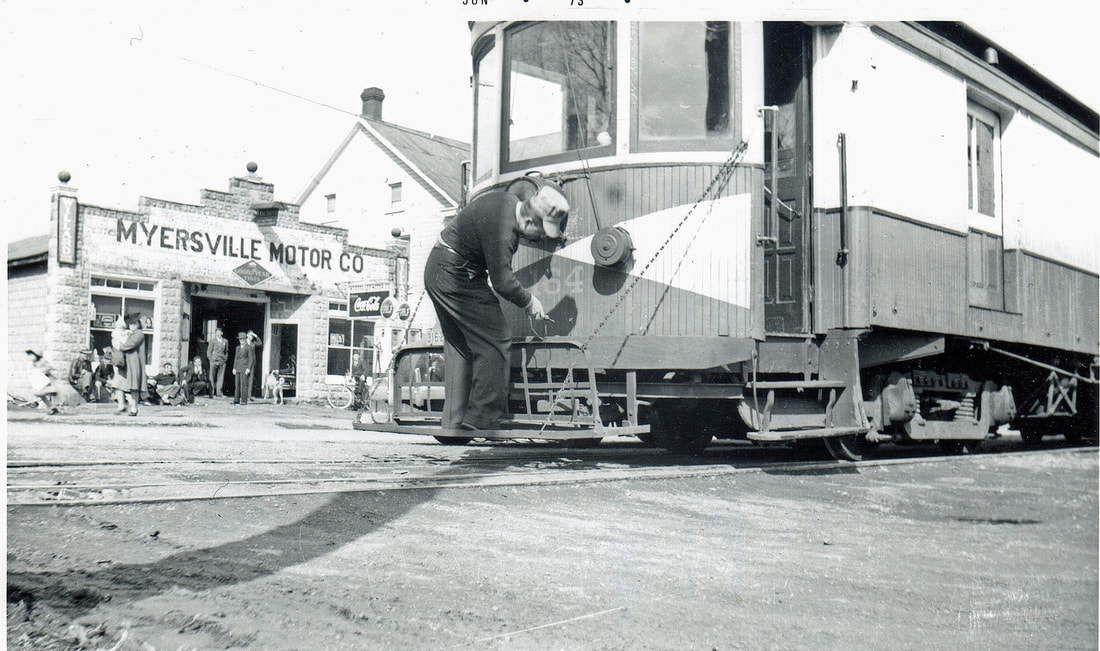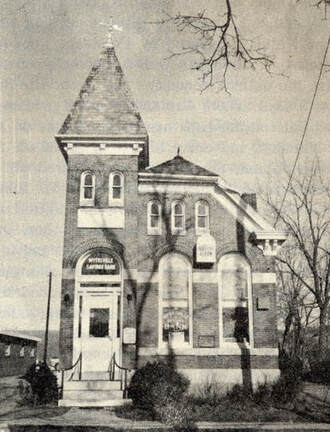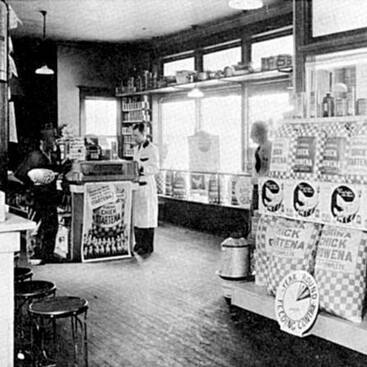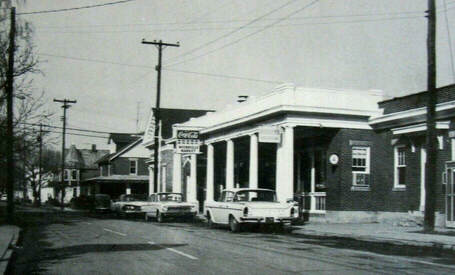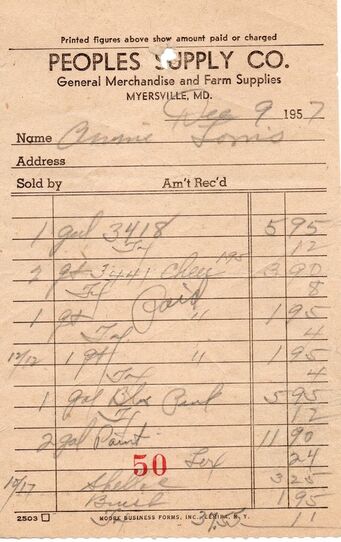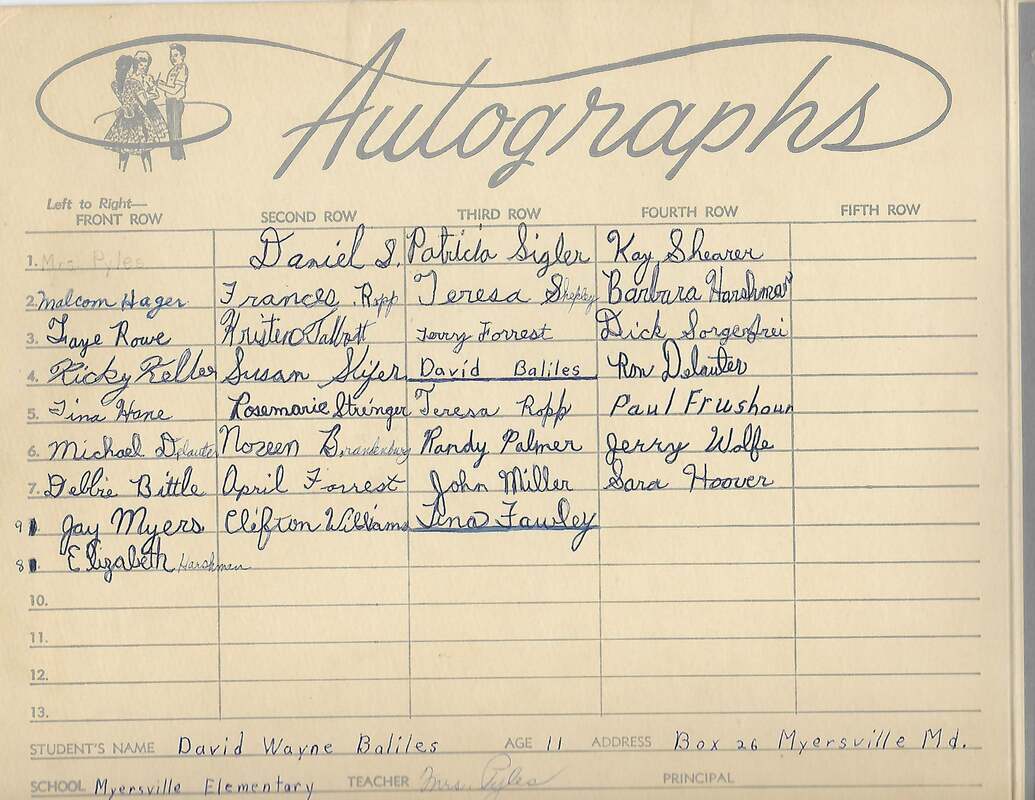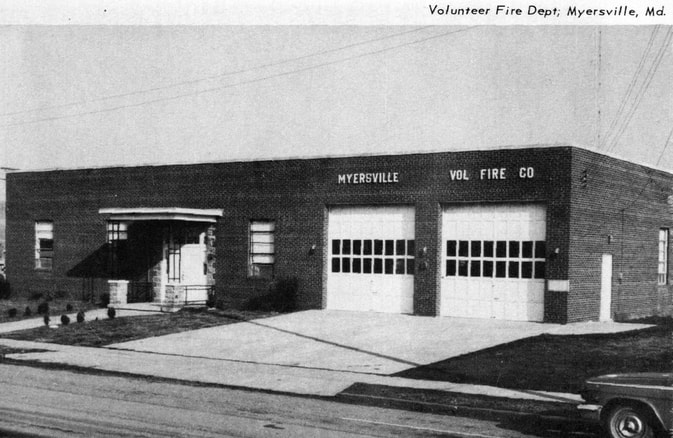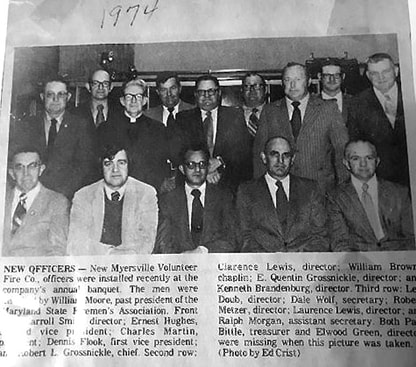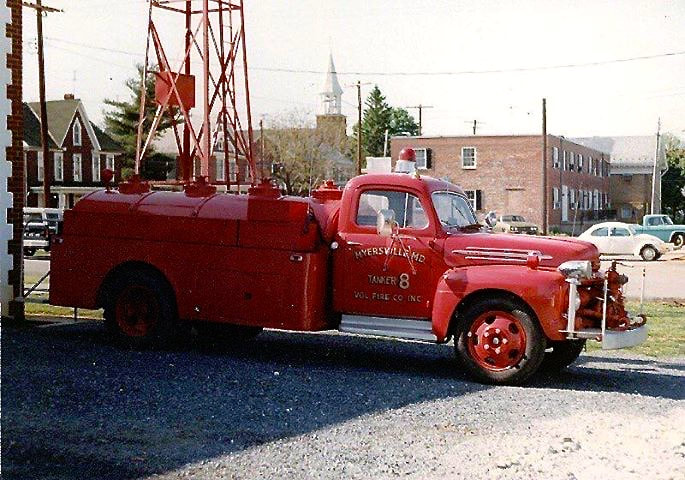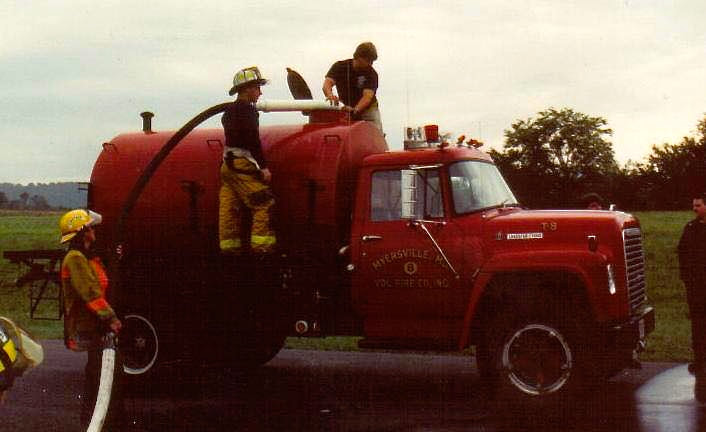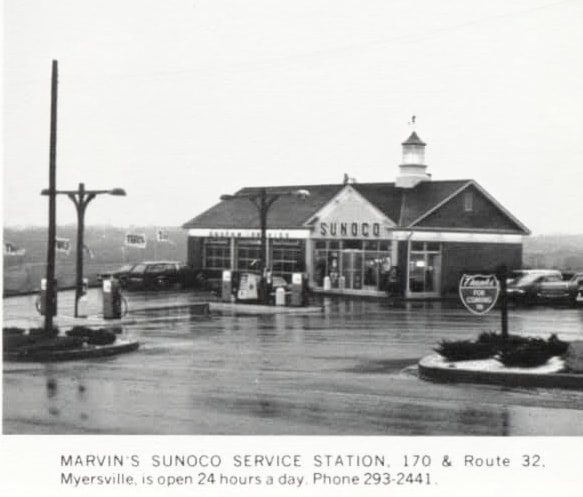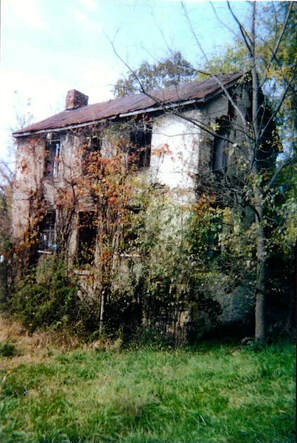Historical Images of Myersville

Old Tavern, Main Street, Myersville, Circa 1905. This building was constructed in 1796 and functioned as a public house. Early merchant Joseph Brown would later build his store beside it. This picture was taken after the trolley came to Myersville in 1898. The old tavern was demolished sometime after 1905, presumably by John Caleb Leatherman, who built a new house (203 Main Street) on the site that was completed in 1909.
During the Civil War, the structure was a hotel run by Maryland Militia Captain Aaron Poffenberger. The Valley Register, 6 September, 1861, reported:
About noon on Monday last a detachment of 30 men from Companies B and F of the 4th Connecticut Regiment passed through this place from Myersville in this valley, having in charge a number of State Rifles, found in the possession of Capt. Aaron Poffenberger, of that village, whom they had previously placed under arrest.
The information against Captain Poffenberger was that he had, by handbill, recently called in these rifles from the possession of persons belonging to a company he commanded from 1845 to 1848, and that he was in the habit of drilling a number of his partisan friends in the use of this deadly arm. He denied that he was a Secession sympathizer and declared himself a Union man. He was then asked to surrender and promptly complied by giving up 4 stands; whereupon he was released from arrest. The rifles have been given to one of the companies of the 'Home Brigade' for guard duty.
During the Civil War, the structure was a hotel run by Maryland Militia Captain Aaron Poffenberger. The Valley Register, 6 September, 1861, reported:
About noon on Monday last a detachment of 30 men from Companies B and F of the 4th Connecticut Regiment passed through this place from Myersville in this valley, having in charge a number of State Rifles, found in the possession of Capt. Aaron Poffenberger, of that village, whom they had previously placed under arrest.
The information against Captain Poffenberger was that he had, by handbill, recently called in these rifles from the possession of persons belonging to a company he commanded from 1845 to 1848, and that he was in the habit of drilling a number of his partisan friends in the use of this deadly arm. He denied that he was a Secession sympathizer and declared himself a Union man. He was then asked to surrender and promptly complied by giving up 4 stands; whereupon he was released from arrest. The rifles have been given to one of the companies of the 'Home Brigade' for guard duty.
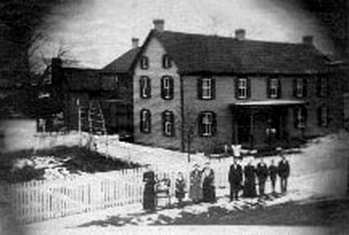
Linebaugh Home, Main Street, Myersville, Circa 1890. This house, today numbered 506 Main Street, was lived in for many years by wagonmaker and farmer Jonathan Linebaugh (1807-1864). His widow, Catherine Shank Linebaugh (1813-1871), remained in the home until her own passing. Afterward, a number of family members emigrated to Ohio, where their descendants remain today.

Flook, Gaver, et al Private Bank, Main Street, Myersville, Circa 1904. The owners and officers of the bank were Cyrus F. Flook, president; George D. Gaver, vice president; John C. Leatherman, treasurer; Dr. A. J. Smith, secretary; Joshua Summers, assistant cashier; and C. Upton Grossnickle. When the bank moved to a brick building constructed next door, this became the Farmers Mutual Exchange. Both it and the bank burned down in January 1919.
Raymer's Carriage Shop, Circa 1895. Left to right: Simon Raymer, Charles J. Bittle, John R. Langdon, and Homer Raymer. First operated by John Hildebrand as the Myersville Carriage Factory, later it would be run by Charles Bittle, Edward Bittle, John R. Langdon, and Homer Raymer.
St. Paul's Lutheran Church Exterior and Interior, Circa 1897. St. Paul's Lutheran Church, Main Street, Myersville, Circa 1900. Genealogist and Historian Bob Fout writes, "One night in the Spring of 1854, Messrs. Joseph Brown, William Metzger and James S. Gladhill, then members of St. John’s Lutheran congregation at Church Hill, met together to discuss the advisability of erecting a Lutheran Church and organization in nearby Myersville. Rev. Christian Startzman, then pastor at St. John’s, was consulted, and gave the project a hearty approval. It was then determined that a church be built and accordingly, a lot – the one on which the present church stands – was purchased and a building committee was appointed. The work on St. Paul’s Lutheran Church was commenced and in the Fall of 1855, this first Lutheran Church in Myersville was dedicated. The total cost was $3,100. However, in April 1872, a fire destroyed the church. In 1874, St. Paul’s Lutheran Church was rebuilt and rededicated at a cost of $7,000." These cabinet card images were taken sometime after the installation of the organ in 1896. Courtesy Krystal Rowley.
A Sketch of a Part of Myersville made by "F.W." on 30 December, 1898. This drawing, from the collection of Jennifer Savaadra, presumably shows a section of Main Street, however, the exact portion has not been identified.

A painting of the Toms Family Farm Outside Myersville, Circa 1900? Courtesy Jennifer Saavadra.
A Section of the Toms Family Farm, Circa 1900. Courtesy Jennifer Saavadra.
Trolley Tracks Being Laid in Front of Joseph Brown's Store and the Old Tavern, 1898. The 1798 tavern is visible just past the store. If one looks closely, some of the legendary "loafers" of Myersville can be seen in action just outside mercantile building.
Right: Ira C. Moser, Owner and Publisher of the Myersville Monitor, Circa 1905. Moser, who bought the paper at age 20, was a great promoter of Myersville, but he met with hostility in the form of major property damage and physical attacks. He wrote The History of Myersville in 1905 and later moved to Ohio, then to Boonsboro. Courtesy St. Paul's Lutheran Church.
Left: Baltimore Sun, 12 April, 1907.
Left: Baltimore Sun, 12 April, 1907.
Main Street, Myersville, with Trolley (Left) and Looking South (Right), Circa 1900. Courtesy Charles Martin family (right).
Right: George Waters Bittle General Store, Main Street, Myersville, Circa 1900. Bittle was shot three times in front of this building in the summer of 1903 whilst trying to stop a robber he identified as George Koogle, son of Civil War Medal of Honor winner Jacob Koogle. Bittle survived and Koogle was prosecuted, but a hung jury resulted and the case was never retried. The Koogle family relocated to Hagerstown.
Top Left: Baltimore Sun, 18 December, 1904.
Below Right: The site of the August 1904 shooting.
Top Left: Baltimore Sun, 18 December, 1904.
Below Right: The site of the August 1904 shooting.
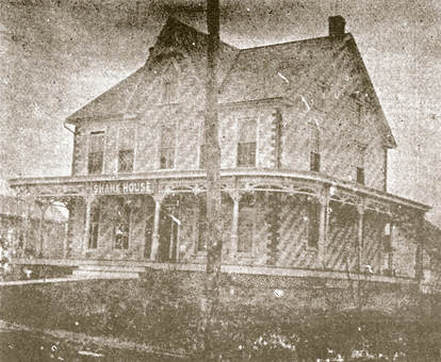
Shank House Hotel, 200 Main Street, Myersville, Circa 1905. The town's former hotel is now a private home. The porch's decorative wood trim survived until a 2016 renovation.
The 1992 Maryland Historical Trust's survey of the town notes, "The two-story frame dwelling built about 1882 has a five-bay east elevation with a center entrance and a one-story porch that wraps around three sides of the house. A cross gable with a pointed arch gable window with 2/2 sash dominates the east elevation. The vinyl siding probably covers rusticated wood siding as shown in a photo in Moser's 1905 History of Myersville. The porch has scroll-sawn trim and turned columns which are also seen in the 1905 view. The roof is composition. The sash is 2/2 in arched frames. The Shank House was a hotel and boarding house from at least the 1890s to the 1920s, when the interurban railway connections appealed to summer visitors from the nearby cities. The photo in the 1905 history indicates the rusticated siding was painted in alternating colors, giving a diagonal striped appearance to the exterior. The quoins were painted a darker color. "
The 1992 Maryland Historical Trust's survey of the town notes, "The two-story frame dwelling built about 1882 has a five-bay east elevation with a center entrance and a one-story porch that wraps around three sides of the house. A cross gable with a pointed arch gable window with 2/2 sash dominates the east elevation. The vinyl siding probably covers rusticated wood siding as shown in a photo in Moser's 1905 History of Myersville. The porch has scroll-sawn trim and turned columns which are also seen in the 1905 view. The roof is composition. The sash is 2/2 in arched frames. The Shank House was a hotel and boarding house from at least the 1890s to the 1920s, when the interurban railway connections appealed to summer visitors from the nearby cities. The photo in the 1905 history indicates the rusticated siding was painted in alternating colors, giving a diagonal striped appearance to the exterior. The quoins were painted a darker color. "

Myersville Post Office, Circa 1905. The house at 310 Main Street was also the residence of Melvin Shepley and his wife Bessie. Shepley was appointed as postmaster in April 1903.
Main Street, Myersville, Circa 1905. This bird's-eye view photograph, looking south, was taken soon after the electric railway began spurring development in Myersville in the early 1900s. The roofs of Rhoe and Bland's Creamery are visible opposite the Lawson Bittle house and store. The long-running mercantile establishment of Joseph Brown can also be seen -- it is the second house beyond the creamery. Also in this image, three women stroll the sidewalk under the sign for The Farmers Mutual Exchange and toward the Central Trust Bank at the intersection Main Street and Route 17. These buildings were destroyed by the fire of January 1919.

Trolley Conductors Beside Trolley 150, Myersville, Circa 1905. The conductor on the left is Roy Cyrus Garnand who later worked for the Washington, D.C. trolley company. Courtesy Bittle family.
Warehouse of Elmer A. Young, Main Street, Myersville, Circa 1905. In 1904, Young purchased the warehouse formerly owned by Toms & Bittle to deal in grain, coal, wood, hay, and machinery.

Hildebrand House, 109 Main Street, Myersville, Postcard, 26 June, 1908. Prosperous carriage maker John T. Hildebrand (1829-1923) built this fine home for himself and his wife, Sophia Brown (1844–1911), the eldest daughter of Joseph Brown. The house still stands today.
The postcard is addressed to "N. B. Weaver, Ellett, Montgomery Co., Va." The message reads, “Mrs. Weaver, Douglas rec’d your lovely card & was delighted with it, so I thought I would like to send you one this time. We never have had any with reading one like you sent him and was pleased with it. Mama is anxiously looking for a letter from you. She thinks you have forgotten her. Did you get hers? Please answer soon. Mama says write soon. I would like to see you. Lovingly, Edward. Douglas will answer yours when I hear from you. He was pleased very much. From Edward McDonough. By by. How is Miss Mary? Tell her to write.”
The card was sent on behalf of George David Routzahn's (1842–1917) grandson, Bernard Douglas McDonough (1901–1918), by the boy's father John Edward McDonough, Sr. (1864–1923). Courtesy Ann Longmore-Etheridge.
The postcard is addressed to "N. B. Weaver, Ellett, Montgomery Co., Va." The message reads, “Mrs. Weaver, Douglas rec’d your lovely card & was delighted with it, so I thought I would like to send you one this time. We never have had any with reading one like you sent him and was pleased with it. Mama is anxiously looking for a letter from you. She thinks you have forgotten her. Did you get hers? Please answer soon. Mama says write soon. I would like to see you. Lovingly, Edward. Douglas will answer yours when I hear from you. He was pleased very much. From Edward McDonough. By by. How is Miss Mary? Tell her to write.”
The card was sent on behalf of George David Routzahn's (1842–1917) grandson, Bernard Douglas McDonough (1901–1918), by the boy's father John Edward McDonough, Sr. (1864–1923). Courtesy Ann Longmore-Etheridge.
Myersville School, Postcard, 15 February, 1908. The school, which sits at the intersection of Main Street and Monument Road, saw later use as, amongst other things, a shirt and pajama factory. Today, it is an apartment building.
The message on the reverse reads: “Miss Bessie Williams, Stephens City, VA. I received your card. We have had powerful rain here and have had heavy snow just before and it is bad to get around. But Mr. Sir holding his meeting in Myersville and I have not missed any at all. [Con't on front] Love to you and mother. High School Myersville. Miss. [?] Stanton.” Courtesy Ann Longmore-Etheridge.
The message on the reverse reads: “Miss Bessie Williams, Stephens City, VA. I received your card. We have had powerful rain here and have had heavy snow just before and it is bad to get around. But Mr. Sir holding his meeting in Myersville and I have not missed any at all. [Con't on front] Love to you and mother. High School Myersville. Miss. [?] Stanton.” Courtesy Ann Longmore-Etheridge.
Children of the Myersville School, 1913. The first two rows only have names attached. From left, front row: Sammy Foltz, Bill Toms, Gail Gaver, Glen Gladhill, Howard Toms, Charlie Harp, Grayson Grossnickle, Douglas McDonough, Ernest Harshman, Grayson Smith, Laurence Beachley, Edward McDonough, Frankie Harp, Paul Gross. From left, second row: Raymond (Petie) Moser, Weltie Michael, Caroll Shepley, Roscoe Shepley, Frank Smith, Mary Harp, Ellen Toms, Florence Garnand, Russell Smith, Lee Garnand, Nora Toms. Courtesy Jennifer Savaadra.
Myersville Class Photo, 1913. At left is Principal Alvey John Horine (1868-1940). MWAHS Collection.
Myersville Native Elmer Jacob Tom and Hettie Grossnickle Toms with their Children, 1909. Elmer Toms was the son of Myersvillians John Henry and Malinda Sensenbaugh Toms. Front L-R: Grace Toms, Elmer Toms, Nettie Grossnickle Toms holding Flora Toms, Austin Toms.
Back L-R: Nellie Toms, Ray Toms, Bettie Toms, John Toms. Courtesy Jennifer Savaadra.
Back L-R: Nellie Toms, Ray Toms, Bettie Toms, John Toms. Courtesy Jennifer Savaadra.
United Brethren Church, Myersville, Postcard (Left: 1899; Right: Circa 1910). The photo at right is from an 1899 newspaper article about the church and its history. The Real Photo Postcard at right dates to between 1910 and 1915. It was addressed to Mrs. Jacob Koogle of Hagerstown, wife of Civil War hero Jacob Koogle, but was not posted. Close examination of the image does not show that stained glass windows have been added, thus dating the image before the 1916 remodeling when ornate windows that still exist today were put in place. The fence and hitching posts reported to have been added during the 1905 remodeling appear in the image. The identity of the man, whose picture is not part of the postcard but cut out and pasted onto it, is unknown. He is presumably the reverend at that time or a visiting preacher. If anyone can identify him, please contact us. Courtesy Ann Longmore-Etheridge.
Below Left: The church's interior in about 1917. Below right: Another photograph of the church dating from about the same time. Courtesy Julia Carlson.
Below Left: The church's interior in about 1917. Below right: Another photograph of the church dating from about the same time. Courtesy Julia Carlson.
Home of Jacob N. Dutrow and Clara Mary Green Dutrow, Main Street, Myersville, Circa 1910. Courtesy Debbie Dutrow.
Routzahn Family Gathering, Circa 1910. Front row: Miriam Horine, Florence Raymer, Ethel Raymer, Mary Harp, Miriam Lizer, Norma Lizer. Second row: Clara Smith, Erma Routzahn, Minnie Biddle Routzahn, Pauline Routzahn, Frank McClellan Routzahn, Roy Ezra Routzahn, Addie Routzahn, Naomi Routzahn. Third row: Esta Lizer, Annie Main, Gratia Remsburg, Ethel Horine, Edna Routzahn, Sallie Harp, Bessie Smith, Betty Horine. Fourth Row: Tilghman Grossnickle, Victor Smith, Calvert Hauver, Dr. Dawson Flook, Elmer Harp, Dr. Oren Gaver, Edwin Johnson, Roy Harp, Elmer Raymer, Elizabeth Routzahn Raymer.
Main Street, Myersville, Postcard, Postmarked May 8, 1911. This image shows the trolley tracks and the fine shade trees lining Main Street, a few of which still survive today. Courtesy Ann Longmore-Etheridge.
Interior, Myersville Church of the Brethren, Circa 1915. Courtesy Debbie Wilson.
Main Street, Myersville, Postcard, June 1918. A passing trolley can be seen, as well as the house that held Myersville's first telephone exchange (first on right). The same house is believed to be the approximate location of the Poffenberger smithy in the 1830s to late 1800s. Behind the white picket fence is now believed to be the location of Poffenberger's well, which served as a de facto town well during those years.
This postcard was mailed from within the town to another Myersville resident. The reverse reads: "To: Mrs. Charles Forrest, Myersville, Md. Dear Sister, I heard the children have the measles. I hope they are over them by this time. Mary wrote to me and told me she wants us all to come down Sun. We expect to go as far as we know. Be sure and go too. Try to meet us at Tabor Station at 9 o'clock or not later than half past at the old time. We will try to be there. Goodbye from Lelah." Courtesy Ann Longmore-Etheridge.
This postcard was mailed from within the town to another Myersville resident. The reverse reads: "To: Mrs. Charles Forrest, Myersville, Md. Dear Sister, I heard the children have the measles. I hope they are over them by this time. Mary wrote to me and told me she wants us all to come down Sun. We expect to go as far as we know. Be sure and go too. Try to meet us at Tabor Station at 9 o'clock or not later than half past at the old time. We will try to be there. Goodbye from Lelah." Courtesy Ann Longmore-Etheridge.

Myersville Farmer Charles O. Easterday with His Swine Breeders by His Barn, 1919. Courtesy Frederick County Extension Office Photographs, Frederick County Public Libraries.
Myersville Team Baseball Players, 1917. Shown are team members Charlie Hauver, Foster Bittle, Russell Grossnickle, Clifford Bittle, Ed Hauver, Upton Harp, Russel Wachtel, Ord Stroop, Leonard Beachley, and Omer Dubel.
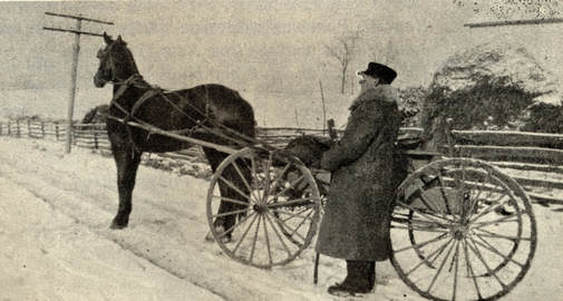
Myersville Rural Mail Delivery, 1918. The postman out on this snowy day was John M. Grossnickle, who also carried the title of town poet. Courtesy Kathy Falkenstein.
Bittle Farm Near Myersville, Circa 1900.
Closeup, Bittle Farm House Near Myersville, Circa 1900.

Myersville Baseball Team Players Russell Wachtel and Russell Grossnickle in Front of the Lawson Bittle Store, Main Street, Myersville, Circa 1918. We know that this picture predates January 1919, when the buildings on the right burned to the ground. Courtesy Debbie Wilson.
Fire Aftermath on Main Street, Myersville, January, 1919. On the fourth of January, a devastating fire destroyed the trolley depot, bank, the Farmers Mutual Exchange, and nearby residences. This image was probably taken from the second floor of the Lawson Bittle store.

A Trolley Passes the Doub Residence on Upper Main Street, Circa 1920. This was the home for many years of Grayson Edgar Doub (1901-1984), who was Myersville's mayor from 1952- to 1964.

Unidentified Proud Myersvillians with Their Newfangled Automobile, Circa 1920.
Probably Myersville United Brethren Church (Now Mt. Zion Methodist), 1923. On the reverse of this Real Photo Postcard image is written, "Inside of our church, Myersville, Md. 1923." The picture likely shows a Harvest Homecoming service at which the congregants helped fill the pastor's pantry for the winter months.

Frederick County Fair Exhibit, 1924. Entitled "Good Health Comes from Within," it was created by the Federation of Rural Women's Clubs of Wolfsville and Myersville. Courtesy Frederick Co. Extension Office Photographs, Frederick Co. Public Libraries.
(Left) Myersville School, Harp Place, Circa 1925. Courtesy Charles S. Martin family. Left: Young students on the steps of Myersville School, circa 1940. MWAHS Collection.
Left: Teacher and students at the old brick school on Harp Place, October 1925. From an album compiled by Hilda Mae Bittle. Amongst the children are Ralph Shank, Robert Gouker, Austin Brandenburg, Harry Keller, Kathleen Summers, Hilda Mae Bittle, Richard Bittle, and Virginia Cline. Right: A group of students poses on the school steps in about 1935. MWAHS Collection.
A Gathering of Myersvillians on a Winter Day, Circa 1925. Included in this group are members of the Marker and Rowe family. Courtesy Nancy Bruce.

The Myersville Band, Circa 1925. During the 1920s, 1930s, and early 1940s, this band flourished, playing crowded open-air concerts on Saturday nights.
Harp Family Reunion, July 1926. This wonderful panorama photo was taken in Main Street, Myersville, outside what is today Mt. Zion United Methodist Church, then Myersville United Brethren Church. Included are the trolley, the church parsonage, and hundreds of Myersvillians. More than 800 of George S. Harp's (1765-1844) descendants attended. Courtesy Summers family.
If you recognize anyone in these pictures, please contact us. Courtesy Summers family.
If you recognize anyone in these pictures, please contact us. Courtesy Summers family.

Motorcars on Main Street, Myersville, Circa 1928. Daniel Carrol Shepley (1908-1961) and Harold Moser (1904-1997) appear up to shenanigans with this early auto.
Myersville Motor Company and Summers Garage, Circa 1925. This picture was taken decades before the building's reincarnations as Ross General Store, a chocolate shop, and J. B. Seafood. Courtesy Summers family.
Myersville Motor Company and Summers Garage (Left) and the Trolley Parked by the Trolley Shed (Right), 1930s. Courtesy Summers family.

Trolley at the Myersville Station, Circa 1930s. A trolley as it makes its way through Myersville in front of the People's Supply. The doorway visible near where the trolley is sits leads into the Trolley Waiting Station. The young boy checking to see whether the trolley can clear the automobile is reportedly Bob Falkenstein, whose parents owned the and operated the store. The trolley waiting station is now marked with a plaque. The top image is a pencil sketch, probably of the below photo, by S. C. McCarrick. It was one of a series of blank stationery cards that date to the 1990s.
Members of the Rowe Family, Circa 1935. Courtesy Nancy Bruce.
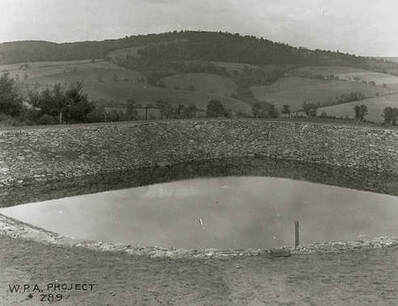
WPA Myersville Reservoir Project, 1935. The reverse of this image reads: "Works Progress Administration of Maryland, Division of Operations. Myersville, Frederick County. Reconstruction of the city water system. Showing the completed reservoir." Courtesy Works Progress Administration of Maryland, Enoch Pratt Free Library.
Trolley 171 on Canada Hill Outside Myersville, 1935. Courtesy Schmidt Photo Collection.
Above and Below: Trolley Traveling Between Middletown and Myersville, 1935. Courtesy Schmidt Photo Collection.
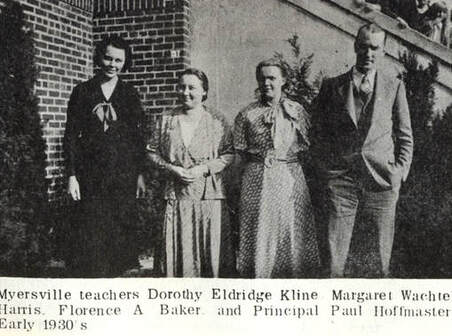
Myersville School Teachers, Circa 1935. Left to Right: Dorothy Eldridge Kline, Margaret Wachter Harris, Florence A. Baker, and Paul Hoffmaster. Some of their students are just visible peeking over the staircase on the right.
Toms Family Photo, circa 1935. In this group shot, the children of Claude Evers Toms and Anna Catherine Grossnickle Toms, pose impishly for their parents. Left to right: William Eston Toms, Janice Claudia Toms Weaver, Earl Allen Weaver, Josephine Annabelle Toms Wycall, Theodore Lean Wycall, Nora Elizabeth Toms Shepley, Atlee Gaver Shepley holding son Atlee Toms Shepley, and Mabel Alice Toms Bittle holding her daughter Blye Bittle. Photo courtesy Jennifer Saavadra.
Above Left: Atlee and Nora Shepley's 1941 Chevrolet. Above Right: Visiting Toms Children's Family Cars Parked at Claude and Annie Tom's Myersville Farm, 1940s. Photos courtesy Jennifer Saavaadra.
Looking south down Main Street, circa 1940. MWAHS Collection.

Route 40 Eastbound at the Modern Intersection of Deerwoods Place During the 1940s. The billboard on the left advertises the Barbara Fritchie Cabins, a motel in Frederick. Courtesy Ann Longmore-Etheridge.
|
Pumper Truck Parked at Myersville's Original Fire Station, Circa 1940s. This pumper was the first unit placed in service at the Wolfsville Volunteer Fire Company when it was a substation to Myersville. The first fire station was attached to the rear of the Town Hall and post office at the corner of Main Street and Route 17. Before the Great Depression, the building had been the Banking House of Flook, Gaver, Leatherman, Summers, Grossnickle, and Company.
Right: Volunteer firefighters Atlee Gaver Shepley (1910-1964) and George Carlton Rice (1912-1988) mug for the camera in the late 1940s. Photo courtesy Jennifer Savaadra.
|
Photo courtesy Brian Grossnickle.
|
Hagerstown & Frederick Railway Trolley 160 on Rudy’s Hollow Trestle Bridge Near Myersville, May 1941.

A Crowd Watches Trolley Repairs, Circa 1940.
The Grossnickle Farm on Brethren Church Road, November 1946 (colorized). Photo Courtesy Donna Grossnickle.
Potomac Edison Woody Station Wagon Drops Off Passengers in Myersville, 1947. This was taken at the intersection of Route 17 and Main Street in Myersville. The driver wears a hat with an H&F RR badge. The Trolley Station was a block from this intersection. The road signs point toward Ellerton, Middlepoint -- which is now no more that a few houses and a garage -- and Wolfsville. Presumably, this station wagon was a part of the P&E /H&F RR system, used to transport riders to and from stations. Photo and information courtesy John A. Kinnaird.
Left: Mrs. Martin's Catechism Class, Myersville Evangelical United Brethren Church (Now Mt. Zion Methodist), Circa 1959. Clockwise: Larry Summers; Gary Gouker; Mary Lee Stevens, Mrs. Martin. Larry Flook; Brenda Fundis; Beverly Fundis; and Larry Dons.
Right: Rev. Martin Outside Myersville Evangelical United Brethren Church (Now Mt. Zion Methodist), Circa 1959.
Summer Bible School at Myersville EUB, 1958. Photo courtesy Mary Stevens Portier.
An Aerial View of Main Street, Myersville, 1956.

Myersville Sewing Circle, 1958. (Front row, L to R) Martha Bullivant, Louyse Falkenstein, and Nancy Summers. (Back row, L to R) Elizabeth Johnson, Alice Schigliano, Nellie Doub, Nellie Cline, Edna Grossnickle, and Eleanor Bittle.
Myersville Savings Bank, Main Street, Myersville, 1960.
Above: A store receipt made out to Annie Toms on 9 December, 1957. Courtesy Jennifer Savaadra.
Right (Top): Matchbook Cover, Peoples Supply Company, Myersville, Circa 1960. Peoples Supply also ran gas pumps. This matchbook promotes Amoco products sold by the store. Courtesy Mark Etheridge. Right (Bottom): A 1953 Middletown High School Yearbook ad by Peoples Supply. Courtesy Base Kuhn.
Myersville School, grade 4, Mrs. Harp, March 1961.
Myersville School, Grade 5, Mrs. Piles, March 1962.
Myersville School, Grade 6, Mr. Van Tries, April 1963.
Mrs. Pyles' Class, Myersville Elementary, Late 1960s. Courtesy David Baliles.
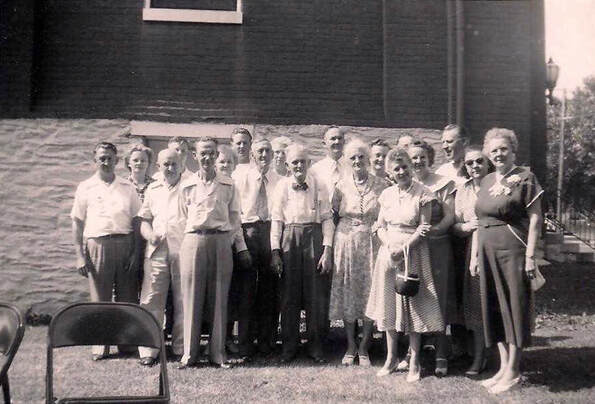
Gathering of the Wilhide Family Outside St. Paul's Lutheran, Circa 1963. John Emmert Shepley is in the center, wearing a bow tie.
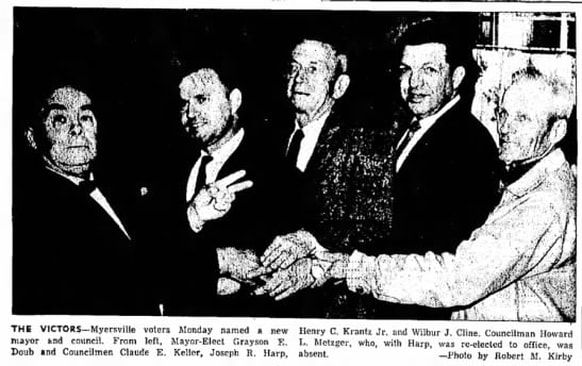
The Victors of the 1966 Myersville Election. From left: Grayson Doub, Claude Keller, Joseph Harp, Henry Krantz, Jr., and Wilber Kline. Hagerstown Herald, 10 May, 1966.

Darryl Boyer (Left) with the Middletown High School Marching Band; Joseph Harp (1894-1973) (Right, Inset) with the Harmony Band, Circa 1968. Both were Myersville residents.
Myersville Troop 273, 1967. Scoutmaster Don Schley, left, shows uniform items to (L to R) Khim Bittle; Don Schley, Jr.; David Gouker; and Bob Gouker. Photo courtesy Kyle Crutchley.

Myersville Church of the Brethren, Circa 1970. Robert Johnson Ridgley donated the land and traveled to the town of Schwartzenau, a borough of Bad Berleburg in today’s North Rhine-Westphalia, to purchase a granite block cornerstone for the church, which was then under construction. The Brethren originated in Schwartzenau so the cornerstone carried great significance to the congregation at home.
Above: Myersville Volunteer Fire Company, Main Street, Myersville, in the 1970s and 1980s. Color images courtesy Brian Grossnickle. (Below Left) Myersville Volunteer Fire Company's Station Under Construction on Main Street, Myersville, Circa 1969. This was the second home of the fire company. Across the street, on the right, is the intersection of Main Street and Monument Road, where the former Myersville School is visible, lacking today's balconies.
Myersville Volunteer Fire Company Officers, 1974. The names include Ernest Hughes, Charles Martin, Dennis Flook, Robert L. Grossnickle, Clarence Lewis, William Brown, E. Quentin Grossnickle, Kenneth Brandenburg, L. Doub, Dale Wolf, Robert Metzer, Laurence Lewis, and Ralph Morgan. Courtesy Brian Grossnickle.
Boy Scout Troop 273 Honor Esther Bittle For Contributions to The Troop, Circa 1971. Left to right: Randy Langdon, Don Schley, Esther Bittle, Bob Gouker, Nelson Langdon.

Camp Echo Lake, Formerly Off Monument Road, Myerville, Circa 1970s. Courtesy (top left) Terry Moats, Mark Dominesey.

John W. Kinnaman Harness and Shoe Shop, 418 Main Street, Myersville, 1992. "This one-story shop dating from the last quarter of the 19th century has been expanded on the west elevation to two levels and converted to residential use. It retains much of its original appearance on the east elevation, with a two-bay elevation under a small gabled porch roof and a single door and 2/2 window. On the south elevation, a modern shed extension joins the rear expansion. The roof is standing seam metal and the concrete-block chimney is located at the west gable end. This is the only example of the small shop among the commercial buildings of the period." (From the Maryland Historical Trust's survey of the town.)

Ross General Store, Main Street, Myersville, 1992. For a number of years, this little store, formerly the Myersville Motor Company, was the heart of town. This photo comes from the Maryland Historical Trust's survey of the town.

Wendell A. Smith (formerly Wheeler A. Smith) Farm, Main Street, Myersville, 1992. The town's first log cabin, which may have dated to as early as 1742, is said to have stood ten feet north of this farmhouse. This photo comes from the Maryland Historical Trust's survey of the town.

The Flook, Gaver, et al. Bank, People's Supply Company, and Trolley Waiting Room, 1992. This photo comes from the Maryland Historical Trust's survey of the town.

Former Myersville School and Lawson F. Bittle General Store, Main Street, Myersville, 1992. This photo comes from the Maryland Historical Trust's survey of the town.
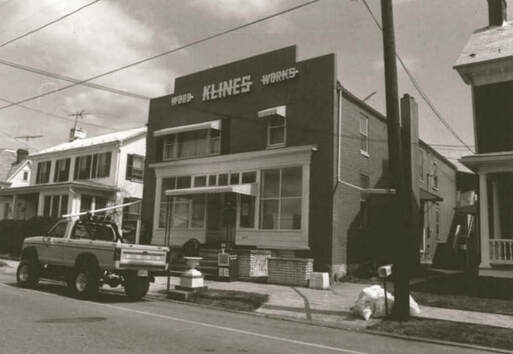
Kline's Wood Works (Formerly the G. W. Bittle General Store), Main Street, Myersville, 1992. This photo comes from the Maryland Historical Trust's survey of the town.
Routzahn House, 513 Main Street, Myersville, 1992. House, wash house, & barn, view from west.

William Green Farmstead, Rum Spring Road, Myersville, 1992. This photo is from a Maryland National Trust survey. The William Green farm is centered on a two-section log and frame dwelling built about 1800 and added to in 1890-1900, with two log outbuildings possibly contemporary with the log part of the dwelling, a rebuilt frame and stone springhouse, and a frame bank barn of about 1850 with an extension of about 1900, a wagon shed, and several frame chicken houses of about the same period.

Smith-Bowlus House, Monument Road, Myersville, Circa 1892. It is a two-story frame dwelling with German siding and a four-bay main elevation with double entrances. Associated with the house is a frame summer kitchen with German siding, a frame chicken house, and a small frame barn. Built between 1862 and 1865 by John Smith, it was sold to Joseph Bowlus in 1865. In the 1990s and early 2000s, it was a daycare center and private home. It was surveyed by the Maryland National Trust in 1992.

Trolley 150 on a Flatbed Truck in Front of Mt. Zion Church, Main Street, 1992. Don Easterday (below) had just acquired the trolley, which had been on the mountain serving as part of a summer house since its retirement.

Charles Donald Easterday (1934-2016) with Trolley 150, Circa 2000. His obituary noted, "He was active in the preservation and restoration of historic buildings. He was a member of the Frederick County Tourism and participated in the Frederick County Museum by Candlelight, hosting tours of the historic structures on the family homestead. He acquired the Hagerstown-Frederick (H&F) Trolley 150 in 1992 and restored the trolley shortly thereafter. In 1994, he established and hosted the Myersville Trolley Festival and attracted trolley enthusiasts from all over the country. This festival was built around his love of the H&F trolley that ran through the local area from 1898 until 1956. Tens of thousands of trolley enthusiasts attended 18 Trolley Festivals between 1994 and 2012." Courtesy Ann Longmore-Etheridge.
Top Left and Bottom Right: The Leatherman farmhouse on Brethren Church Road, Myersville. The house was built in about 1850 by the Shindler family, who lived in it during the Civil War. The house was abandoned circa 1945, with its barn burning down in 2001. Photos courtesy Stanley Leatherman.
Top Right: Amongst those who called this house home were John Caleb Leatherman (1852-1952), George Carlton Leatherman (1858-1955), David O. Leatherman (1857-1922), Charles Theodore Leatherman (1855-1946), Julia Malissa Leatherman Harshman (1862-1958), Clara Rebecca Leatherman Grossnickle (1851-1963), Sarah Catherine Leatherman Derr (1856-1956).
Bottom Left: Elder George Leatherman (1827-1907).
Top Right: Amongst those who called this house home were John Caleb Leatherman (1852-1952), George Carlton Leatherman (1858-1955), David O. Leatherman (1857-1922), Charles Theodore Leatherman (1855-1946), Julia Malissa Leatherman Harshman (1862-1958), Clara Rebecca Leatherman Grossnickle (1851-1963), Sarah Catherine Leatherman Derr (1856-1956).
Bottom Left: Elder George Leatherman (1827-1907).

Main Street, Myersville, "Snowpocalypse" of January 2010. Photo Courtesy Ann Longmore-Etheridge.













